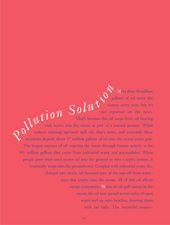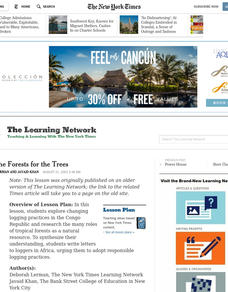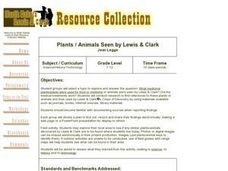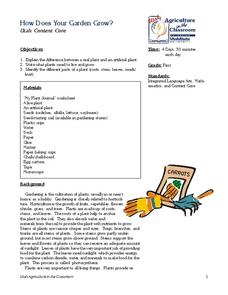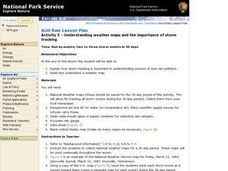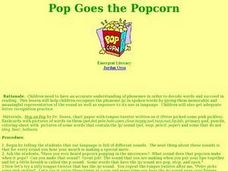Curated OER
Identifying Erosion
Students identify erosion in various forms and explain its causes. They look for evidence of erosion on school grounds, describe it in their journals, and draw labeled rough sketches of the erosion.
Curated OER
Carbon Cycle Game
In this carbon cycle lesson, middle schoolers review the carbon cycle and visit stations in the room where they experience every phase in the carbon cycle. Students journal about their journey through the cycle and brainstorm ways...
Curated OER
Erosion
Fifth graders study the effects of running water on erosion. They examine how the soil on the playground is affected by erosion and determine how the placement of trees and shrubs changes the path of erosion. In their science journals,...
Curated OER
Pollution Solution
Fourth graders examine how trees help to absorb the pollution that is emitted from automobiles. They review the process of photosynthesis and determine how forest management is important on their reservation. They think about the...
Curated OER
Pharaoh Mountain Hike: Investigating Adirondack Life Zones
Students hike a local mountain and examine its life zones. They measure various components at each zone and collect leaf litter at the sites. At the mountain top, students make descriptive observations and complete a handout about the...
Curated OER
Renewable vs. Non-Renewable Resources
Fifth graders are introduced to the important topic of renewable, and non-renewable, resources. They are expected to be able to correctly categorize different types of resources as renewable or non-renewable. Another emphasis of this...
Curated OER
Seeing the Forests for the Trees
Students explore changing logging practices in the Congo Republic and research the many roles of tropical forests as a natural resource. To synthesize their understanding, students write letters to loggers in Africa, urging them to adopt...
Curated OER
Ecosystems: Biotic and Abiotic Factors
Seventh graders examine proper journaling techniques, and record observations about at tree after listening to a read aloud of "Four Worlds: The Dine Story of Creation." They study the difference between living and non-living things, and...
Curated OER
Look At Those Leaves!
Young scholars observe, measure, and sort tree leaves. They examine leaves individually, in groups, and in relationship to the entire tree. Pupils take a walk outside for a "Leaf Walk." Students are each given a lunch size paper bag, so...
Curated OER
Discovering Forest Products
Learners identify attributes of natural and manufactured wood products. In this forest products instructional activity, learners perform independent research to find an article about forest use or forest products. They spread out samples...
Curated OER
Plants / Animals Seen by Lewis & Clark
Students conduct research to find references to plants or animals and their uses by Lewis & Clark's Corps of Discovery by using materials available such as journals, books, internet sources, library materials. Groups create a...
Curated OER
Big Fat, Juicy Worms
Pupils collect and study information about worms. They discover how an earthworm helps process and loosen the soil. They write in their journals as well.
Curated OER
Treasure Hunt
Students actively search a the ground outside and find several types of leaves, lichen, feathers and trash. They place items into journals, write entries, draw pictures and ask questions about the items found on their exploration.
Curated OER
How Does Your Garden Grow?
Students identify what plants need to grow. In this plant biology lesson, students analyze the differences between an artificial plant and a live plant. Students plant seeds and discuss what plants need to grow. Students observe the...
Curated OER
Plant Propagation
Students successfully start a new plant by any means of vegetative propagation. They select a propagation method which is appropriate for the plant and keep a laboratory journal of the treatment and progress of the new plant.
Curated OER
Guided Reading "In the Night Sky"
Students participate in a variety of reading exercises, such as choral reading and reading response journal, to reinforce concepts about space and nocturnal animals.
Curated OER
Understanding Weather Maps and the Importance of StormT
High schoolers explain how storm tracking is important to understanding sources of acid rain pollution. The read and explain a weather map. They set up plastic or glass collection container for rain in an open area away from buildings...
Curated OER
POP! Goes the Popcorn!
Students complete a variety of activities based on examining corn and popcorn as one of the major crops of Kansas. They journal the results of the multidisciplinary activities in this unit.
Curated OER
Science: The Age of the Redwoods
Students discover how to estimate the age of redwood trees. They measure the trees' diameters by using string to calculate the circumferences. Students conclude by discussing the science of dendrochronolgy.
Curated OER
Science: How Tall Are Plants
First graders investigate plant growth and examine what factors contribute to plant growth. They keep a class chart of plant growth and write about and illustrate their conclusions.
Chicago Botanic Garden
Preparing for Project BudBurst
Male deer growing antlers to begin the breeding season is an example of a phenological event. First in a four-part series is an activity requiring individuals to collect phenological data on their campus. Classes discuss phenology, the...
Chicago Botanic Garden
Preparing for Project BudBurst
Plants take cues from the environment—change in daylight hours and temperature—to complete their seasonal life cycles. Lesson four in the series of six has classes collect phenology data on plants. After taking initial observations,...
Curated OER
A Discourse on the History of Language
Analyze and make inferences from the information used by linguists to construct the evolution of languages. They research different dating techniques to explain how scientists infer age with evidence.
Curated OER
Renewable vs. Non-Renewable Resources
Here's a fine lesson on renewable and non-renewable sources of energy for your 5th graders. In it, learners list a number of natural resources on the board, then try to sort the resources into appropriate categories. This helps them to...



